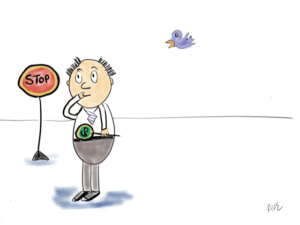
What’s wrong with these people? Don’t they see the stock price is tanking? How do I get people to move? How do we turn this ship around? Will we make it?
Often leaders are frustrated when they sense that things are not moving fast enough or that there is not enough energy to create lasting change. How do they enhance the co-creation and action for results?
They often try to instill urgency by making staff changes. However, this can create more fear and uncertainty rather than engendering co-creation and collaboration. Other times, leaders resort to platitudes such as “the train is leaving, get on or off now.” Again, while these statements may promote short-term compliance, they do not seem to sustain commitment and action.
The challenge is that leaders generally are seeing things from a different perspective and need to engage in open-minded conversations with their teams. A leader needs to clearly share the urgent need for transformation while understanding the needs of team members.
I have worked with many leaders who have been able to share their view and listen to the perspectives of their colleagues and then create shared meaning and a vision that inspires action for change. The value of taking some time for real conversation cannot be overestimated. Unfortunately, some feel they are too busy to engage in these essential and transformational conversations.
When all the voices are heard (initially through pre-meeting interviews) and a respectful and open environment is created, the urgency and focus emerges. An honest dialogue about the current situation and needs, without making people wrong, provides space to imagine what is possible. You can engage people to create a shared vision and a concrete plan for action. The powerful energy available when a shared sense of meaning is created is inspiring. The team can tap into a creative energy for change and then there is urgency and the excitement of working collectively for a shared goal. Rather than getting on the train, the team is forging a new path together with all the energy of experienced hikers and they bring along the rest of the organization. Mobilizing such energy is what makes being a leader and a part of an organization exciting.
After working with a leadership team to align around a shared vision the leader shared that a senior hire candidate indicated that he was excited to see the alignment of the senior team and wanted to join in the exciting venture. They had not been able to hire for the critical position before the team had engaged in open-minded dialogue and co-created a shared plan to urgently create changes in their business. Their energy and excitement after facilitated dialogue was contagious and extended throughout the organization. There is nothing like the power of engaged hearts and minds tapping into creativity. The results followed.
We love supporting leaders in deepening their ability to do this. It’s fun and rewarding for everyone. One way we support leaders with this is in working with them to create a Transformational Leadership Retreat. We’d love you to join us at our next seminar, in which we share the 6-question coaching model we use for leaders and their teams.
Creating urgency and powerful meaning is one of the topics we discuss in Use Your Next Leadership Retreat to Launch a Transformation: Learn the Process September 24 from 12 – 4:30 at the Catalyst Ranch in Chicago. Learn more here.
Jackie Sloane and Ann Van Eron are seasoned executive coaches, and work together with leaders to create transformational interventions and retreats for public sector, corporate, privately-held and not-for-profit entities.




 “I don’t know what direction to pursue.” “Should I change jobs or start a business or stay with my current role?” “Should we have a baby?” “Should I apply?” “Should I say yes?”
“I don’t know what direction to pursue.” “Should I change jobs or start a business or stay with my current role?” “Should we have a baby?” “Should I apply?” “Should I say yes?” 



